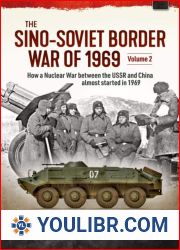
BOOKS - The Sino-Soviet Border War of 1969: Volume 2 - Confrontation at Lake Zhalanas...


US $8.51

805122

805122
The Sino-Soviet Border War of 1969: Volume 2 - Confrontation at Lake Zhalanashkol, August 1969 (Asia@War)
Author: Dimitry Ryabushkin
Year: August 26, 2021
Format: PDF
File size: PDF 8.5 MB
Language: English
Year: August 26, 2021
Format: PDF
File size: PDF 8.5 MB
Language: English
The communist victory in the Chinese civil war resulted in the formation of a new socialist state - the People's Republic of China. The Soviets were the first to recognize the PRC, and subsequently provided China with considerable assistance. After Stalin's death, however, relations rapidly deteriorated over disagreements regarding Stalin's legacy and co-existence with capitalist states.With the 'cultural revolution' in the PRC, these disagreements the two sides accused each other of revisionism, dogmatism and nationalism. Economic failures and social chaos forced the PRC leadership to seek a method for divesting itself of responsibility for what had taken place. As a solution, they organized a military conflict on the border with the Soviet Union to rally the people around the PRC leadership, while at the same time insignificant enough in scale to prevent it from escalating into a full-fledged war.On 2 March 1969, a specially prepared Chinese army detachment made a surprise attack on Soviet border guards patrolling the border in the area of Damansky Island on the Ussuri River. In the subsequent battle, the dead on both sides numbered more than 50. On 15 March 1969, a much larger battle took place in this same area, in which both sides used artillery and armoured vehicles; the casualties numbered in the hundreds.There were conflicts along the entire Sino-Soviet border - from Primorye to Central Asia - in the following weeks and months. Although smaller in scale than the Damansky events, men still died. Shooting on Damansky continued practically into mid-September.On 13 August 1969 there occurred one more large-scale military clash, in the area of Lake Zhalanashkol, after which the political leadership of the USSR and PRC recognized the very real possibility that the border war might escalate into a full-scale war, with the potential use of nuclear weapons.The second volume of this two-part mini-series examines events from 15 March 1969 until the conclusion of the conflict. Principal attention is focused on a detailed chronological description of the battles, Soviet and Chinese tactics, and the weapons used. Inasmuch as the present state policies in Russia and China are aimed not only at keeping silent about the 1969 events, but also opposing any attempts to study what happened in detail, the authors have relied on finding veterans of the battles and obtaining from them documentary evidence of those distant events. The authors believe that this study is the most detailed and objective work on the theme of the 1969 Sino-Soviet border war.














































